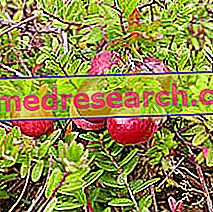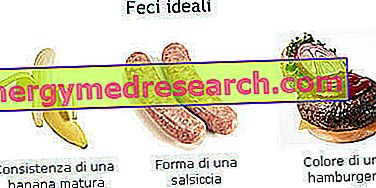
Scientific name
Vaccinium macrocarpon Aiton
Family
Ericacee
Origin and Botanical Description
American cranberry or cranberry is an evergreen shrub of North American origin, very botanically similar to our blueberry. It grows wild in North America in acid marsh soils and is therefore also known as American red marsh Mirztillo. The cranberry flower is white or light pink, bell-shaped. The fruit, small and reddish, is pulpy and sour.
Synonyms
American cranberry or cranberry, American marsh cranberry
Used Parts
The drug consists of fruits, whole, fresh or frozen, or in the form of Cranberry juice
Chemical constituents
The main chemical constituents of the cranberry are:
- proanthocyanidins;
- Flavonoids, among which we find quercetin;
- Catechins;
- Tannins;
- Citric acid;
- Malic acid;
- Glucuronic acid;
- Beta-carotene;
- Glutathione;
- Vitamin E;
- Ascorbic acid;
- fibers;
- Protein.
Cranberry in Herbal Medicine: Cranberry Property
The cranberry (or American cranberry, if you prefer) is part of the composition of various food supplements with indications to promote the correct functionality of the urinary tract and to prevent any bacterial infections.
In these preparations, it can be found either alone, or in association with other plants with properties similar to his.
Biological activity
Cranberry is widely used in herbal medicine to prevent urinary tract infections, although the use of this plant has not obtained official approval for any type of therapeutic indication.
Despite this, there are several studies supporting the antibacterial properties ascribed to the cranberry.
In several controlled studies, in fact, the cranberry - in addition to exhibiting marked antioxidant properties - has proved effective in the prevention and treatment of recurrent and chronic urinary tract infections.
In this regard, an interesting meta-analysis was developed in 2004 (Jepson RG, Mihaljevic L, Craig J. Cranberries for preventing urinary tract infections ) which investigated the effect of various cranberry preparations on urinary tract infections.
In the aforementioned meta-analysis seven controlled clinical studies were included: in five of these the effect of cranberry juice versus placebo was examined; while the other two studied the effect of cranberry in capsules versus placebo.
Cranberry-based products have shown, compared to placebo, to be able to significantly reduce the incidence of urinary infections after twelve months. No significant differences emerged as regards the efficacy between the American cranberry juice and capsules, and the side effects were scarce and similar to those of placebo.
The meta-analysis therefore concluded that both the juice and the cranberry capsules may be effective in reducing the incidence of urinary infections, although many patients have abandoned therapy during its course.
Furthermore, it is important to underline the fact that different cranberry preparations and doses have been used in the various studies. Therefore, it is not entirely clear which is the ideal duration of the treatment and what are the best quantities and concentrations to obtain the desired effect.
With regard to the mechanism of action by which the American cranberry exerts its antimicrobial action, it was initially hypothesized that this activity was related to the plant's ability to acidify urine, making them less hospitable for bacterial proliferation. Subsequent studies have instead shown that the main mechanism of action does not depend so much on the ability to acidify the urine, but rather on the ability of the plant to inhibit the adhesion of microorganisms to the cell membranes of the urinary epithelium of the host.
In particular, an in vitro study showed that cranberry is able to exert a powerful inhibition of the cellular adhesion of Escherichia coli fimbriato (one of the most common etiological agents of urinary infections, involved in about 80% of cases) and other Gram-negative pathogens (such as, for example, Proteus mirabilis and Pseudomonas aeruginosa ) that infect the urinary tract.
This activity appears to be due to proanthocyanidins, polyphenols that selectively inhibit the adhesins produced by bacteria, thus reducing their adhesion to the host's uroepithelial cells and favoring their elimination with urine. The most active proanthocyanidins in this sense seem to be those of type A that, in fact, are majority in the "American cranberry phytocomplex".
However, the cranberry does not seem effective in releasing the bacteria that have already adhered to urinary epithelial cells. Its effectiveness, therefore, would seem greater in preventive terms.
The anti-adhesive activity of cranberry juice can also be useful in preventing the adhesion of oral flora bacteria to the teeth, which are involved in the formation and stability of dental plaque; analogous speech for the Helicobacter pylori, etiological agent of many cases of peptic ulcer.
Furthermore, cranberry is rich in monomeric and polymeric phenolic compounds which perform a protective action on cells against free radicals, protecting them from oxidative damage, with a beneficial and protective effect also on a cardiovascular level.
Cranberry to prevent urinary infections
As mentioned, the use of cranberry has not been approved for any therapeutic application.
Despite this, its use to prevent urinary tract infections has become widespread, also in light of the results obtained by the various studies conducted on the subject.
deepening

The pili or fimbriae can be compared to the tentacles of an octopus, while the adhesins to the suction cups distributed on their surface.
The adhesins are located in the pili or fimbriae present on the bacterial surface, and are able to adhere to specific monosaccharidic and / or polysaccharidic receptors located on the surface of the cells of the bladder epithelium. In this way, the bacterium completes the adhesion phase, neutralizing the washing action of the urine (one of the natural defense mechanisms against urinary infections).
THE. coli presents 2 types of adhesins, morphologically similar, but which bind to two different receptors:
- type 1 pili - expressed by both uropathogenic and non-uropathogenic strains - have D-mannose (mannose-sensitive) as their receptor.

- the P-fimbriae expressed only by uropathogenic strains, bind to a polysaccharide receptor (mannose-resistant). The American cranberry PACs show very strong inhibitory activity against "mannose-resistant" adhesins (fimbriae-P).
For this reason mannose and cranberry are often associated within natural supplements and remedies to fight urinary infections.
Cranberry in folk medicine and homeopathy
Cranberry was used in the past by American Indians both in the common diet and as a medicine to treat kidney stones and other urinary problems. The sailors, instead, used it for the prevention of scurvy, thanks to its content of vitamin C.
Furthermore, cranberry has also been used in traditional medicine for the treatment of type 2 diabetes and chronic fatigue syndrome, as well as being used as a diuretic, antiseptic, antipyretic and even anti-cancer drug.
Currently, cranberry is not used in homeopathic medicine.
Daily dose and method of use
For the prevention of urinary tract infections, it is usually recommended to take 500-750 ml of cranberry juice per day, to be administered in three divided doses. However, it is good to remember that the amount of juice to be taken depends on its concentration. For example, in the case of pure juice - which must be previously diluted in water - it is usually recommended to take 80-160 ml of product per day.
In children the usually recommended dose of juice (not pure) drops to 18-25 mg / kg of body weight per day.
For the juice, the reference constituents for the quality of the finished product can be considered type A proanthocyanidins, whose concentration in the products on the market is about 1.2- 1.4%.
Instead, the dry extract available on the market is generally titrated at 15% of polyphenols. We recommend taking one capsule (300 mg) 2-3 times a day, between meals and with water.
Side effects
The cranberry is usually well tolerated. However, very high doses - for example 3-4 liters of juice a day - can cause gastrointestinal disorders and diarrhea.
A consumption of more than a liter of juice a day, carried out for prolonged periods, can increase the risk of formation of kidney stones of uric acid (due to the acidifying action at urinary level).
Contraindications
Avoid taking cranberry in case of known hypersensitivity to one or more components, in case of allergy to acetylsalicylic acid and in patients suffering from atrophic gastritis, hypochloridria, kidney stones and diabetes (in the latter case, use of the cranberry is contraindicated only if the preparations that contain it and that are to be used are sweetened with sugar).
Furthermore, due to the risk of formation of kidney stones of uric acid, the use of American cranberry is also contraindicated in patients with hyperuricosuria.
Pharmacological Interactions
Cranberry or its preparations can establish drug interactions with drugs, such as:
- Warfarin, as the concomitant administration of American cranberry may potentiate the anticoagulant effect of the drug itself. The interaction between cranberry juice and warfarin is biologically plausible, as warfarin is metabolised by cytochrome P450 (CYP2C9) and cranberry juice contains flavonoids that inhibit CYP enzymes. Although there is a lack of conclusive data, vigilance is advised in the simultaneous administration of cranberry and warfarin.
- H2 receptor antagonists and proton pump inhibitors, since the concomitant intake of the plant can reduce its therapeutic efficacy.




